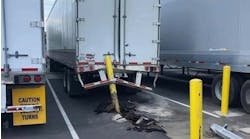Technology has become an essential part of the trucking industry. If walking a short distance around an industry trade show floor, one is bound to pass several technology and software company booths—and the number of booths is growing each year as more and more fleets integrate management software, operational efficiency tools, and preventive maintenance tech into their operations. With all this software and technology to choose from, it’s possible that some fleets now have more data and more “connected” solutions than they can use or even manage.
Can too many fleet management tools be a problem?
“There are many facets of fleet management, and often I hear fleet managers procure each solution as a need arises,” Bri Perry, Fleetio product marketing manager, told FleetOwner via email.
She mentioned technology such as telematics, which helps with asset tracking and driver behavior; fuel cards, which give fleet managers visibility into fuel spend; maintenance software, which allows fleets to track the total cost of ownership for a single asset and/or a whole fleet of assets and simplifying the maintenance process, among others.
See also: Pre-Check: AI in fleet management today
A recent report from fleet management company Motive stated that 46% of fleet leaders surveyed said they used more than 10 individual tools to manage their fleet operations. Another 30% of fleet leaders said they use too many tools even to count.
While fleet managers decided to employ these systems for a reason, Perry said fleet customers she’s spoken to have admitted that the more systems fleets employ, the more difficult it can be to manage them because each management solution must itself be managed— "from the asset data itself to users and permissions to making sure cards or devices are mapped accurately across those systems,” Perry explained.
This management goes beyond ensuring the software is connected to the right vehicle, pulling the necessary data, and functioning as it should. Managing these systems also means ensuring all the right people have access.
“Software can greatly increase transparency among team members, but someone, or a few key people, should be in charge of user permissions and managing contacts to make sure the people who need access to the data have it,” Perry said.
The problem with data silos
Speaking of data, when not managed properly, it can become a problem.
Each fleet management platform and software service captures data from the vehicle and other assets. This can be engine data, driver behavior data, GPS data, and more. What does a fleet leader do with multiple systems collecting multiple data sets? Often, a fleet leader views that data on a dashboard and, depending on the system or service provider, that dashboard can simplify the data into “insights” to help improve decision-making.
If the service provider doesn’t provide those easy-to-digest insights, the fleet leader doesn’t know where to look, or the amount of connected systems simply overwhelms a fleet leader, that data sits in a silo.
“Data silos prevent fleets from seeing the whole picture of their fleet operation,” Perry explained to FleetOwner. “Data in a silo is prevented from being accessed by the rest of the organization, leading to an incomplete picture. If a fleet has multiple data silos, then they either have to spend a large amount of additional time stitching it together, or more likely, they just make the best decisions they can with the incomplete data they have.”
Making decisions that aren’t based on data can negatively affect fleets. Perry used examples such as rightsizing, procurement, and expansion. For instance, if a fleet manager is tasked with rightsizing the fleet and unloading underused assets, deciding which assets to unload is nearly impossible without the data to inform the decision.
Managing fleet management systems
While fleet managers might find it challenging to manage their fleet systems, it’s likely those systems aren’t going anywhere—fleet leaders need the data they provide. What can change, however, is how fleets manage these fleet management platforms.
See also: Akin: How to choose a fleet management solution
The same Motive report found that 80% of fleet leaders surveyed agree that having a "single end-to-end solution to manage physical operations would make their jobs easier." Fleet leaders can accomplish this through integrations. Many fleet management service providers allow integrations within their platforms or integrate into other platforms to simplify overall fleet management.
Uptake, a preventive maintenance platform, integrates with multiple fleet management providers, taking the data that the telematics system receives from the vehicles and running it through Uptake algorithms to keep fleet vehicles maintained, Scott Sweitzer, Uptake director of strategic partnerships, told FleetOwner at an industry conference in February. Uptake is just one example of many platforms that thrive on integration. Integrations with fuel cards are also popular among the fleet leaders Perry has spoken to.
“These integrations improve fleet-wide visibility and optimize daily workflows through automation,” Perry told FleetOwner. “Integrations can eliminate data silos because they allow for the flow of data between solutions. Some integrations help centralize data used for business insights into one place, so fleet managers get the benefit of primarily using and learning one solution with the breadth of multiple."
Further, according to Perry's conversations with these fleet leaders, fleets that implement and successfully manage fleet management software and platforms have a couple of things in common. Those commonalities are having a defined goal and finding strategies and the right telematics and management partners to help get there as well as having company-wide buy-in.
“[The goal] can be as simple as wanting to digitize inspections or automate maintenance reminders,” Perry said. “Having a few goals of what success looks like can help drive conversations with software providers and ensure they can meet your needs.”
With company buy-in, Perry said fleet managers have told her that having all staff on the same page and using the fleet management software has been integral to the success of implementing fleet management software.
“If only half of an organization uses the software and the other half doesn’t buy in, it creates more work,” Perry told FleetOwner. “If you can help teams understand how software will ultimately benefit them, efficiency will naturally follow as more people work to find automations and workflows they didn’t have access to before.”
See also: Increase fuel efficiency using a fleet management system, electrified fleet products
Implementing new systems or processes into fleet operations can be challenging, especially with connected and data-rich systems as fleet management systems. Some fleets intentionally take time between software acquisitions to “acclimate” and become accustomed to one digital workflow at a time before implementing another, Perry explained.
“While it takes time at first,” Perry said, “the long-term benefits of automation and data insights often outweigh the setup time.”




